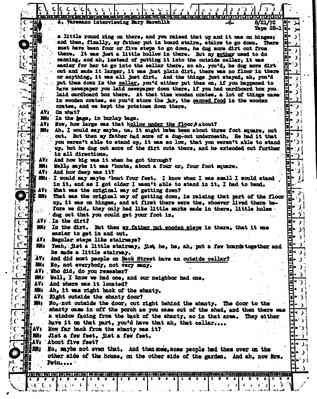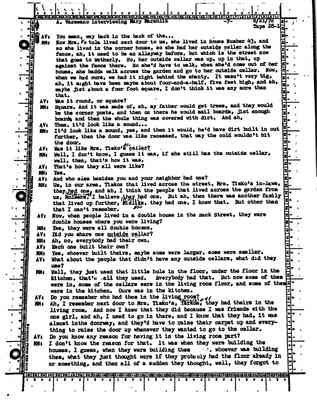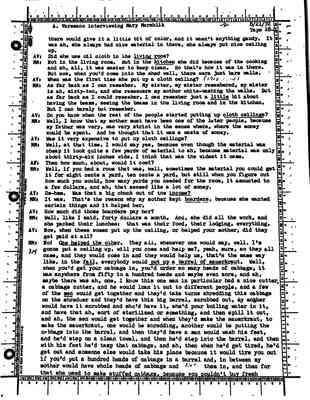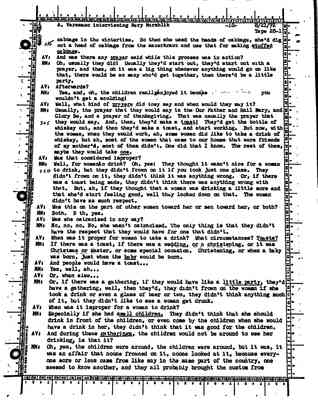Pages
8
A. Varesano interviewing Mary Marshlik 8/21/72 Tape 28-1
a little round ring on there, and you raised that up and it was on hinges; and then, finally, my father put in board stairs, stairs to go down. There must have been four or five steps to go down, he dug more dirt out from there. It was just a little hollow in there. But my mother [mother underlined] used to do canning, and ah, instead of putting it into the outside cellar, it was easier for her to go into the cellar there, so ah, you'd, he dug more dirt out and made it larger, it was just plain dirt, there was no floor in there or anything, it was all just dirt. And the things just stayed, ah, you'd put them down in the cellar [cellar underlined], you'd either put them on, if you happened to have newspaper you laid newspaper down there, if you had cardboard box you laid cardboard box there. At that time wooden crates, a lot of things came in wooden crates, so you'd store the jar, the canned food [canned food underlined] in the wooden crates, and we kept the potatoes down there. AV: On what? MM: In the bags, in burlap bags. AV: Now, how large was that hollow under the floor [hollow under the floor underlined], about? MM: Ah, I would say maybe, um, it might have been about three foot square, out out. But then my father had more of a dug-out underneath. He had it that you weren't able to stand up, it was so low, that you weren't able to stand up, but he dug out more of the dirt outa there, and he extended out further in all directions. AV: And how big was it when he got through? MM: Well, maybe it was 'bouta, about a four or, four foot square. AV: And how deep was it? MM: I would say maybe 'bout four feet. I know when I was small I would stand in it, and as I got older I wasn't able to stand in it, I had to bend. AV: What was the original way of getting down? MM: That was the original way of getting down, is raising that part of the floor up, it was on hinges, and at first there were the, whoever lived there before we did, they only had like little marks made in there, little holes dug out that you could get your foot in. AV: In the dirt? MM: In the dirt. But then my father put wooden steps [my father put wooden steps underlined] in there, that it was easier to get in and out. AV: Regular steps like stairways? MM: Yeah, jist a little stairway, jist, he, he, ah, put a few boards together and he made a little stairway. AV: And did most people on Back Street [Back Street underlined] have an ouside cellar [outside cellar underlined]? MM: No, not everybody, not very many. AV: Who did, do you remember? MM: Well, I know we had one, and our neighbor had one. AV: And where was it located? MM: Ah, it was right back of the shanty. AV: Right outside the shanty door? MM: No, not outside the door, out right behind the shanty. The door to the shanty came in off the porch as you came out of the shed, and then there was a window facing from the back of the shanty, so in that area. They either have it on that part, you'd have that ah, that cellar. . . . AV: How far back from the shanty was it? MM: Jist a few feet, jist a few feet. AV: About five feet? MM: No, maybe not even that. And then some, some people had them over on the other side of the house, on the other side of the garden. And ah, now Mrs. Petu. . . .
9
A. Varesano interviewing Mary Marshlik 8/21/72 Tape 28-1 AV: You mean, way back in the back of the... MM: Now Mrs. Fatula lived next door to us, she lived in House Number 43, and so she lived in the corner house, so she had her outside celler along the fence, ah, it used to be an alleyway before, but which is the street now that goes to Wetherly. So, her outside cellar was up, up in that, up against the fence there. So she'd have to walk ], when she'd come out of her house, she hadda walk across the garden and go to her outside cellar. Now, when we had ours, we had it right behind the shanty. It wasn't very big, ah, it might have been maybe about four-and-a-half, five feet high, and ah, maybe jist about a four foot square, I don't think it was any more than that. AV: Was it round, or square? MM: Square. And it was made of, ah, my father would get trees, and they would be the corner posts, and then on there he would nail boards, jist enough boards, and then the whole thing was covered with dirt. And ah, AV: Then, it's look like a mound... MM: It'd look like a mound, yes, and then it would, he'd have dirt built in out further, then the door was like recessed, that way the cold wouldn't hit the door. AV: Was it like Mrs. Timko's cellar? MM: well, I don't know, I guess it was, if she still has the outside cellar, well, then, that's how it was. AV: That's how they all were like? MM: Yes. AV: And who else besides you and your neighbor had one? MM: Um, in our area, Timkos that lied acroos the street, Mrs. Timko's in-laws, they had one, and ah, I think the people that lived across the garden from us, Molmers [Molo???? #39]. I believe they had one. But ah, then there was another family that lived up further, Midliks, they had one, I knew that. But other than that I can't remember. AV: Now, when people lived in a double house in the Back Street, they were double houses where you were living? MM: Yes, they were all double houses. AV: Did you share one outside cellar [underlined]? MM: Ah, no, everybody had their own. AV: Each one built their own?t MM: Ah, I remember next door to Mrs. Timko's, Yerkos, They had theirs in the living room. And now I knew that they did because I was friends with the one girl, and ah, I used to go in there, and I know that they had, it was almost in the doorway, and they's have to raise their carpet up and everything to raise the door up whenever they wanted to go to the cellar. AV: Do you know any reason for having it in the living room part? MM: I don't know the reason for that. It was when they were building the houses, I guess, when they were building them, whoever was building them, what they just thought were if they probably had the floor already in or something, and then all of a sudden they thought, well, they forgot to
10
A. Varesano interviewing Mary Marshlik 8/21/72 Tape 28-1 put an opening in for a cellar, and maybe for that reason, I don't knowwhat the reason was for that in some places, in some houses it was in the kitchen and some houses it was in the living room. AV: I see. To get back to the living room [underlined], what were/what was on the walls? MM: Ah, holy pictures [underlined]! And you'd be surprised how many of them.... AV: Wait a minute (laughs), on wallpaper? MM: Well, no, now the Back Street houses were made different than these houses. These on Main Street [underlined] had plaster on the walls. The Back Street [underlined] houses had no plaster. They were just double boards. And then they were, ah, white washed [underlined], and after the white wash, then they were wall-papered [underlined]. When people started to wall-paper, then they started to wall-paper. But ah, there wasn't any plaster at all on the walls in those houses. Those houses were cold. AV: And was your house wall-papered? MM: Later it was. From the beginning, it wasn't. From the beginning it was white-washed. AV: Did it have that bluing in it? MM: Yes. Yes. Um-hmm. AV: Um. Then, you say-a, what was on the ceilings [underlined] at first, do you remember? MM: At first there was jist, you'd see the bare beams. And then later they would ah, I don't know who thought up the idea of putting cloth [underlined]... AV: Did they white-wash [underlined] them first? MM: Ah, yes, they used to white-wash them... AV: With bluing... MM: Yes, 'bout twice a year they used to do it. AV: With the bluing color. MM: Right. And then they ah, someone started by ah, I don't know where they saw it or where they heard it, but then they started to ah, they got enough material and they ah, sewed the pieces together to make it the whole width of the ceiling, and the length of the ceiling. And then they would start, it took maybe two or three to put the ceiling up.... AV: Women, or men, did that work? MM: Women, mostly. Sometimes some men would help their wives, but at that time men didn't help the women too much. And ah, you had to take and you had to start nailing in the corner, and then you would stretch, you'd pull on the material as much as you possibly could, and you'd get one corner in, and then you'd pull it across as tight as you could and keep nailing it, all along the one end first til you'd come to the other corner. And then, ah, as you were going, you were, one would be on one side, another one would be on the other side, and they'd be pulling and nailing at the same time, and the nails were quite close together, and they used carpet tacks for that. And ah, that's how they would, ah, nail it up, and it would be real tight, very tight. But after it would be up for a length of time, then you would see it sagging, because of the cooking in the house, you know, and the dust that would settle in there and everything, then that would start to sag. And, well, it would be up for a few years, and ah, then someone got the idea that maybe instead of cloth, if they used a table oil cloth [underlined], then they could wash it, it wouldn't, if, if it did get soiled you'd be able to wash it. Because I know we had, in our kitchen [underlined] on the ceiling we had a table oil cloth, and I can remember it was a red background with a little black print. AV: UM-hmm. How about the one in the living room [underlined]? MM: Well, in there my mother always had, it would be a white background with either a little tiny flower, a little rose or something or another thing
11
A. Varesano interviewing Mary Marshlik 8/21/72 Tape 28-1 there would give it a little bit of color, and it wasn't anything gaudy. It was ah, she always had nice material in there, she always put nice ceiling up. AV: Did she use oil cloth in the living room (underlined)? MM: Not in the living room. But in the kitchen (underlined) she did because of the cooking and ah, all, it was easier to keep clean. So that's how it was in there. But now, when you'd come into the shed well, there were just bare walls. AV: When was the first time she put up a cloth ceiling (1913 xxx) MM: As far back as I can remember. My sister, my sister remembered, my sister is ah, sixty-two, and she remembers my mother white-washing the walls. But as far back as I could remember, I can remember just a little (underlined) bit about having the beams, seeing the beams in the living room and in the kitchen. But I can barely but remember. AV: Do you know when the rest of the people started putting up the cloth ceilings (underlined)? MM: Well, I know that my mother must have been one of the later people, because my father was very, was very strict in the sense where, where the money would be spent. And he thought that it was a waste of money. AV: Was it very expensive to put up cloth ceilings? MM: Well, at that time, I would say yes, because even though the material was cheap it took quite a few yards of material to ah, because material was only about thirty-six inches wide, I think that was the widest it came. AV: Then how much, about, would it cost? MM: Well, if you had a room that was, well, sometimes the material you could get it for eight cents a yard, ten cents a yard, but still when you figure out how much you would, how many yards you needed for the room, it amounted to a few dollars, and ah, that seemed like a lot of money. AV:Um-hmm. Was that a big chunk out of the income (underlined)? MM: It was. That's the reason why my mother kept boarders (underlined), because she wanted certain things and it helped her. AV: How much did those boarders pay her? MM: Well, like I said, forty dollars a month. And, she did all the work, and she packed their lunches: that was their food, their lodging, everything. AV: Now, when these women put up the ceiling, or helped your mother, did they get paid at all? MM: No! One helped the other (underlined). They all, whenever one would say, well, I'm gonna put a ceiling up, will you come and help me?, yeah, sure, so they all came, and they would come in and they would help us, that's the same way like in the fall (underlined), everybody would put up a barrel of saurkraut (underlined). Well, when you'd get your cabbage in, you'd oder so many heads of cabbage, it was anywhere from fifty to a hundred heads and maybe even more, and ah, maybe there was ah, one, I know this one man in particular had a nice cutter, a cabbage cutter, and he would loan it out to different people, and a few of the men (underlined) would get together and they'd take turns shredding this cabbage on the shredder and they'd have this big barrel, scrubbed out, my mother would have it scrubbed and she'd have it, she'd pur boiling water in it, and have that ah, sort of sterilized or something, and then spill it out, and ah, the men would get together and when they'd make the sauerkraut, to make the sauerkraut, one would be shredding, another would be putting the cabbage into the barrel, and then hey's have a man would wash his feet, and he'd step on a clean towel, and then he'd step into the barrel, and then with his feet he'd tamp that cabbage, and ah, then when he'd get tired, he'd get out and someone else would take his place because it would tire you out if you'd put a hundred heads of cabbage in a barrel and, in between my mother would have whole heads of cabbage and xxxx them in, and then for that she used to make stuffed cabbage, because you couldn't buy fresh
12
A. Varesano interviewing Mary Marshlik 8/21/72 Tape 28-1 cabbage in the wintertime. So then she used the heads of cabbage, she'd dig out a head of cabbage from the sauerkraut and use that for making stuffed cabbage (underlined). AV: And was there any prayer (underlined) said while this process was in action? MM: Oh, usually they did! Usually they'd start out, they'd start out with a prayer, and then, oh it was a big thing whenever annything would go on like that, there would be so many who'd get together, then there'd be a little party. AV: Afterwards? MM: Yes, and, oh, the children really enjoyed it because you wouldn't get a scolding! AV: Well, what kind of prayers (underlined) did they say and when would they say it? MM: Uusally, the prayer that they would say is the Our Father amd Hial Mary, and Glory Be, and a prayer of thanksgiving . That was usually the prayer that they would say. And, then, they'd make a toast, and start working. But now, with the women, when they would work, ah, some women did like to take a drink of whiskey, but ah, most of the women that came to our house that were friends of my mother's, most of them didn't. One did that I know. The rest of them, maybe they would take one (underlined). AV: Was that considered improper? MM: Well, for women to drink? Oh, yes! They thought it wasn't nice for a woman to drink, but they didn't frown on it if you took just one glass. They didn't frown on it, they they didn't think it was anything wrong. Or, if therewas a toast being made, they didn't think there was anything wrong with that. But, ah, if they thought that a woman was drinking a little more and thatshe'd start feeling good, well they looked down on that. The women didn't have as much respect. AV: Was this on the part of other women toward her or men toward her, or both? MM: Both. Both, yes. AV: Was she ostracized in any way? MM: No, no, no. No, she wasn't ostracized. The only thing is that they didn't have the respect that they would have for one that didn't. AV: When was it proper for women to take a drink? What circumstances? Toasts (Underlined)? MM: If there was a toast, if there was a wedding, or a christening, or it was Christmas or Easter, or some special oocasion. Christening, or when a baby was born, just when the baby would be born. AV: And people would have a toast... MM: Yes, well, ah... AV: Or, when else... MM: Or, if there was a gathering, if they would have like a little party, they'd have a gathering, well, then they'd, they didn't frown on the woman if she took a drink or even a glass of beer or two, they didn't think anything much of it, but they didn't like to see a woman get drunk. AV: When was it improper for a woman to drink? MM: Especially if she had small children. They didn't think that she should drink in front of the children, or even come by the children when she would have a drink in her, they didn't think that it was good for the children. AV: And during these gatherings, the children would not be around to see her drinking, is that it? MM: Oh, yes, the children were around, the children were around, but it was, it was an affair that noone frowned on it, noone looked at it, because every-one more or less came from like say in the same part of the country, one seemed to know another, and they all probably brought the custom from




